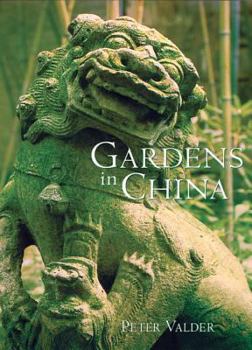Gardens in China
Select Format
Select Condition 
Book Overview
In this new companion book to The Garden Plants of China , Peter Valder describes more than 200 gardens he has visited in China. He documents temple courtyards and gardens, evocative enclosures of ancient burial grounds and imperial tombs, and public parks, botanical gardens, and arboreta, most of which have sprung up since 1949. Gardens in China is illustrated with more than 500 color photographs, many of them depicting gardens not previously illustrated in any Western publication, as well as reproductions of illustrations of historical interest. With their distinctive characteristics, the gardens of China are among the most fascinating in the world. This book is essential reading for visitors to China with an interest in gardens, garden history, and Chinese culture.
Format:Hardcover
Language:English
ISBN:0881925551
ISBN13:9780881925555
Release Date:July 2002
Publisher:Timber Press (OR)
Length:400 Pages
Weight:4.00 lbs.
Dimensions:1.2" x 8.7" x 11.5"
Related Subjects
By Region Crafts & Hobbies Garden Design Garden Furnishings Gardening Gardening & LandscapingCustomer Reviews
3 ratings
Almost as good
Published by Thriftbooks.com User , 15 years ago
Rich in information, indispensible for its coverage of the diversity of Chinese garden types (particularly temple gardens), written for the same audience as his 1999 book, concentrating on plants and planting, this is a travel guide to over two hundred gardens in China (although, because of its weight and size, one that you'd leave in your hotel room). Structured similarly to the previous book, with good introductions to each section with individual verbal descriptions of each garden with 1, 2 or a few more photos (including some historical comparisons). Two disappointments: there are only two Chinese characters in the whole text (no names), reducing its utility for scholars, and there are no maps of sites, plans or other drawings that would make it more useful for designers.
The beauty of the garden
Published by Thriftbooks.com User , 22 years ago
Peter Valder first became interested in GARDENS IN CHINA, from learning about famous planthunters in the 19th and early 20th centuries. His first trip, in 1980, was only as one of a small group visiting cultivars of camellia reticulata in Kunming and a famous plant collecting site, at Emei Shan. He went back to China 14 years later, on a photograph trip of wisterias.At that point he realized three important things. First, he had a basically correct understanding of Chinese gardens, from the famous willow-pattern porcelain. The Thomas Turner design, from 1779, showed the Chinese garden as it tended to be, with water; trellis work; rocks; fancifully-shaped plants, such as the weeping willow; and buildings.What the author went on to learn was that what was in Chinese gardens was based on specific Chinese beliefs. Two main sources for these beliefs were Daoism and Buddhism. Daoists believed in people and world as one, particularly through nature. But nature didn't have to look like nature. The Chinese didn't have the Native American respect for keeping the landscape and nature as close to how they were naturally. The Chinese in fact had no problem changing watercourses, making hills and lakes, and putting in buildings, as focal points, memorials and scenic viewpoints.The ancient Chinese believed immortal beings flew about on the backs of cranes. These immortals supposedly lived on the islands of Fangzhang, Penglai and Yingzhou, in the eastern sea off the coast of Shandong. So islands were made in lakes, in the hopes of getting immortals to land there.Likewise, Xiwangmu, Queen Mother of the West, supposedly lived in the Kunlun mountains. Whoever ate peaches from her beautiful orchards there lived forever. So Chinese gardens often had fake mountains. Mountains were also among the places where the immortals lived. They were important in Daoism and Buddhism too. Daoists worshipped five mountains, as standing at the corners and center of the Chinese world. Buddhists worshipped heavenly and sacred peaks, which they called, respectively, Mounts Sumeru and Potalaka.These fake mountains often had caves in them. This was because a beloved Chinese scholar, Tao Yuanming, was famous for telling a story about a fisherman who walked through a cave, into a utopian world. Caves could also be homes for the immortals. So caves became common in Chinese gardens.Likewise, plants and trees were often chosen for definite reasons. One was because of what they called to mind from Chinese art, everyday life, and literature. So Chinese horse chestnut, ginkgo, juniper, pine, and thuja became traditional garden trees. Bamboo, chrysanthemum, cymbidium, marvel of peru, pine, plum, and yucca became traditional garden plants. Citrus, figs, large-flowered gardenias, and jasminum sambac became traditional potted plants.Second, how the Chinese traditionally designed their gardens ended up, later, as common parts of Western gardening. They actually had among our earliest rock, topiary an
Simply Marvellous
Published by Thriftbooks.com User , 22 years ago
Peter Valder has now established himself as one of the world's major horticultural writers with his "Gardens in China" the new companion volume to his wonderful, award winning, "Garden Plants of China". This book looks at over 200 gardens that the author has visited over a period of twenty years. It is a richly descriptive work both historically and geographically and is extremely readable, to the point that it is almost impossible to put down. The photography once again is simply stunning. Besides the famous classical gardens of Suzhou Valder gives a fascinating overview of temple courtyards , parks, cemeteries, botanical gardens and arboreta(many established since the cultural revolution) in every corner of this vast country. If you are contemplating a visit to China there could be no better preparation than reading Valder's "Gardens in China". If you are not going to China then travel there vicariously via this magnificent book. A must for every serious garden lovers bookshelf.






